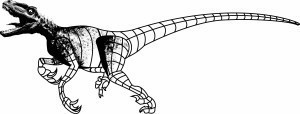Two velociraptors stalk through the kitchen as the children crouch. What little light there is shines upon what should be the feathers of these mysterious predators. Somehow, dinosaurs have returned from extinction.
Jurassic Park’s portrayal of dinosaurs is not without its flaws. However, the film succeeded at introducing the technology that may bring extinct species back to life. The techniques used to create ‘saurians’ is not radically different from the de-extinction concept (the ressurection of species through genetic and cloning technology) developing today. The film was also a trailblazer in the field of computer-generated imagery (CGI). Although most of the dinosaurs in the movie were animatronics, the raptors were entirely digital—a breakthrough for CGI in the ’90s.
De-Extinction
In the film, CEO John Hammond brings dinosaurs back to life after he discovers dinosaur DNA trapped in mosquitoes preserved in amber. Alhough the DNA is incomplete, Hammond fills in the empty gaps with frog DNA, creating all varieties of dinosaurs to populate his theme park: Jurassic Park.
Such manipulation of species’ DNA was a difficult concept in 1993. Techniques used to determine the details of an organism’s DNA were just starting to see the light of day. DNA is written in a code of four molecules called nucleotides (A, T, C, and G). By sequencing DNA, scientists can determine what order the nucleotides are in, allowing them to gain further understanding of the function of the code. In the early ’90s, however, genetic sequencing was still slow-moving. The entire genome of the influenza bacteria—a minute fraction of a dinosaur’s genome—was only completely sequenced in 1995.
The technology necessary to recreate species is so complex that scientists have just started contemplating the possibility very recently. Since 1983, various projects have emerged to restore animals such as the passenger pigeon, the Tasmanian tiger, as well as woolly mammoths and sabre-toothed tigers.
The project to revive North America’s passenger pigeon is headed by expert Ben Novak and evolutionary molecular biologist Beth Shapiro at University of California Santa Cruz. Novak and Shapiro have been collaborating since 2012 in efforts to bring back the species that last flew in 1914.
The team uses a technique called gene sequencing to analyze the genome of the pigeon. The genome they assemble is then compared to the bird’s closest evolutionary relative, and any pieces that are different are compared and removed at the Harvard lab.
This new genetic code is then inserted into germ cells—special cells that eventually become ova or sperm. The hope is that the cells will successfully proliferate in the womb of the host species and develop into the pigeon.
It sounds simple, but most of the procedure involved is untested and still being researched. Genetics is a complicated field with many factors that are not completely understood. Still, there are hopes that extinct species may once again roam the earth.
Computer Generated Imagery (CGI)
Special effects have played an integral part in movies for years. With CGI so omnipresent in today’s films, it is hard to imagine a time when movies were made without animation. Jurassic Park paved the way for graphics with its computer-generated velociraptors in the concluding scenes of the film.
Thanks to CGI, the velociraptors moved with a grace that would have been difficult to approximate with physical models. For the first time, a fantastical element like a dinosaur was not a close-up shot of a lizard or a stop-motion figure.
The technology used to create these dinosaurs was based on a logical evolution from filmmaking of the past. Similar to physical figures, artists made small models of dinosaurs that were subsequently copied with a laser onto a computer. The animators then added joints and moved the model around on screen.
The digital dinosaurs offered an advantage over the physical models of the past: there were no limitations to the movement of the figure—previously restricted by wires and rods—allowing for more life-like motion.
Despite failures in CGI such as 1982’s Tron, filmmakers began to take advantage of the technology after Jurassic Park. Films like Casper and Jumanji improved upon the concept that was first introduced in Jurassic Park. Toy Story was the first completely computer-animated movie to appear in theatres. The rest was, as they say, history.










THIS ARTICLE IS EXCELLENT
THANK YOU FOR YOUR EXCLLENC